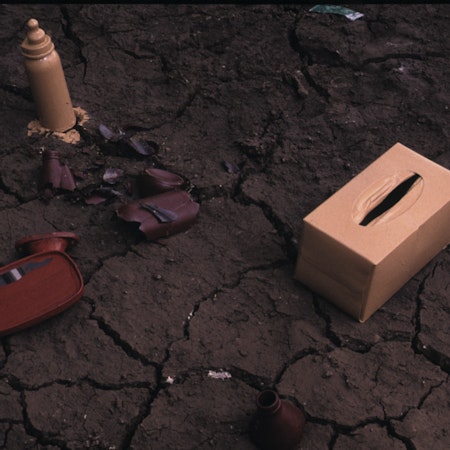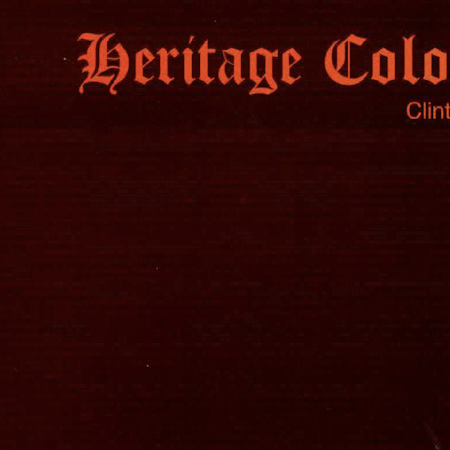Culture not only seeks its identity in symbolic forms, but also seeks to maintain itself through such forms. The landscape is one form through which cultural groups seek to create and preserve their identities.
Heritage Colours represents and reclaims the urban landscape of inner city Melbourne, exposing and challenging the way dominant cultures maintain their values and sense of identity through the symbolic forms they create. Clinton Nain comments on the predominant use of colours and decoration associated with Victorian architecture and subsequent labelling of these colour schemes as 'heritage colours'. He asks the question: how does colour reflect heritage, and whose heritage is reflected in specific colour schemes and architectural ornamentation?
The architectural landscape so rigorously maintained and preserved in urban, metropolitan areas such as Fitzroy, reflect a culture's need to define itself in relation to a period in history remembered as progressive and steeped in European ideals. The values and aspirations of a community in the late 1800s are reflected through an architectural language that conveys a sense of permanence, order and opulence.
In July 2000, the present Prime Minister, four past Prime Ministers and a large delegation of elected officials celebrated Australia week in London. Why was the foundation of our nation celebrated in London? "Is the origin of the nation officially in the Houses of Parliament in London where the Act of the British Parliament establishing the Commonwealth of Australia lies behind glass?" We remember and celebrate ANZAC Day, Remembrance Day and Australia Day with patriotic fervour. We preserve and maintain an urban landscape that celebrates the colonisation of the land and the construction of landscape through which the dominant cultural group seeks to preserve a sense of identity.
In Melbourne in 1996, Clinton Nain exhibited Island Magic, created from his experience of visiting his family on Darnley Island in the Torres Strait. Influenced by Bing Crosby's nostalgic ballad Island Magic that tells a story of an elusive dream of a carefree paradise, Nain constructs his own island paradise from Island brand soap.
"If I used the soap in the shower, I would become clean and sweet-smelling and see this island destroyed, washing away down the plug hole with the water. As I built my island, I feared what greed could do to Darnley. If the island of my family is not respected, there could be tar and concrete everywhere soon and mother earth will disappear like an Island soap down the drain."
The artist reveals a nostalgia for the land, but it is not a nostalgia for a picturesque arcadia, it is for the stories and memories of the place and the land as a home for his family. He fears that their stories will be covered over, washed away and sanitised.
Big Red Cloud 1999, evokes a dramatic turbulent landscape in the symbolic colour of Aboriginal land. The artist has used White King bleach to mark the surface, the bleach has not completely removed the colour, leaving a stain that delineates the landscape. The residue of the action remains, a violent action, that if not removed will continue to rot and slowly corrode the surface it has been applied to. Nain exposes the violent and insidious whitewashing of his history, but also suggests that while a residue remains, stories and traditions are remembered and celebrated, a culture "cannot cannot be extinguished or bleached out of existence."
In Heritage Colours, Nain has constructed a complex, chaotic landscape viewed through the gallery's imposing Victorian facade. Digitally reproduced iron lace frames the view onto the gallery floor that has been covered in mud. Large bluestones encircle the mud restricting its flow further into the space. Discarded domestic objects collected from the surrounding area lie encased in 'heritage colour' paint on the muddy surface. They are the overlooked, disused, forgotten objects of this urban landscape, collected and re-presented. A broken plate, part of a bed and a crumpled car door; fragments of past actions and experiences covered in 'heritage colours'. What are the alternative histories hidden behind the ornate facades and colours? What stories and memories did these objects represent? Heritage Colours reveals a multi layered landscape that reflects a diversity of heritages.
In the far corner, a film of a street of endless iron lace fences plays continuously, preserving the past and the future.
(1) Bourassa, "Landscape Aesthetics & Criticism" in H. Edquist (ed.) The Culture of the Landscape Architect, 1994, p.100
(2) M. Langton, "The Frontier goes to London" in LIKE Art Magazine No. 12, Winter, 2000, p.5
(3) C. Nain, "evidence" in S. Comte (ed.) Next Wave Festival Visual Arts Catalogue, Melbourne, 1996, p.26
(4) Artist statement from G. Lee "Clinton Nain" in B. Croft, Beyond the Pale Adelaide Biennial of Australian Art 2000, Adelaide, 2000, p.46

